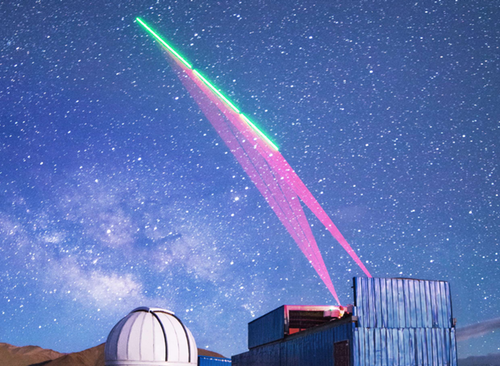China and Austria used a satellite link to exchange quantum encrypted data for images and a video stream, a first step toward a secure “quantum internet.”

Eye in the Sky. The satellite Micius relayed quantum-secure signals between China and Austria. This time-lapse photo shows the Xinglong observatory’s red laser tracking the satellite as it moves across the sky, emitting a green laser beam that appears as a single point at any instant
Communication with digital signals encrypted quantum-mechanically can be more secure than with classical signals, prompting forecasts of a “quantum internet” for global data protection. Such a project now looks more feasible thanks to a demonstration in which researchers shared images and a video connection that were quantum-mechanically secure between stations in China and Austria, linked by a satellite.
Like any form of digital encryption, quantum cryptography uses a string of bits (1’s and 0’s) called a key to encode and decode information. But in the quantum version, the bits are represented as quantum states—for example, the polarization states of photons. Pairs of quantum bits (qubits) in the key are quantum-entangled, meaning that the states of the pair are interdependent; the sender keeps one qubit and sends the other to the receiver. The laws of quantum mechanics make it physically impossible for the transmitted qubits to be intercepted and read without this eavesdropping being detectable by the sender and receiver.
Quantum key distribution (QKD) is the process of sending the key in this quantum-secure way, which keeps the encoded message safe, even if the message is sent without a quantum protocol. QKD between two remote locations has previously been demonstrated for signals sent along optical fibers over many kilometers [1, 2], but light signals sent using a satellite relay would suffer less attenuation en route. Recently, Jian-Wei Pan of the University of Science and Technology of China (USTC) in Hefei and his co-workers reported QKD using laser beams between the Xinglong observatory in China and a low-orbit satellite called Micius [3]. This satellite is the first to have quantum-processing capability and was launched by China in 2016. Pan’s group, in collaboration with Anton Zeilinger and others at the University of Vienna, has now extended the satellite link so as to permit QKD between Xinglong and Graz, Austria, via Micius, over a distance of 7600 km.
Micius can create quantum keys and can also broadcast and measure quantum-encrypted signals. It can send separate, single-use, random quantum keys to the Xinglong and Graz stations by laser pulses as it passes over each location. The sender—say, at Graz—uses the Micius-Graz key to encode data, and Micius can then include this key in the signal it sends to Xinglong, encrypted with a different Micius-Xinglong key.
To demonstrate the cryptographic link, the researchers sent two images between China and Austria via the satellite and used fiber-optic networks to extend the connection from Graz to Vienna and from Xinglong to Beijing. They sent a digitized image of Micius (the Chinese philosopher after whom the satellite is named) from Beijing to Vienna and a picture of the quantum physicist Erwin Schrödinger (who worked in Vienna) from Vienna to Beijing. Each file contained about 5 kilobytes of data.
In a further demonstration of the scope of the link, it was used for a secure videoconference between the Chinese Academy of Sciences in Beijing and the Austrian Academy of Sciences in Vienna—a 75-minute discussion that required 2 gigabytes of data. The capability demonstrated here, says Pan, “is sufficient for the very early stages of a quantum internet, similar to the state of cell phones in the 1970s.” He anticipates that the first real applications of this network will include encrypted voice calls, faxes, and email for transmitting sensitive financial or diplomatic information.
“This is the first demonstration of intercontinental quantum key distribution of any kind, and it will stand as a milestone towards future quantum networks,” says Ronald Hanson of the Technical University of Delft in the Netherlands, who is working on long-distance quantum telecommunication for a quantum internet.
Micius is a critical component of a larger, Chinese-led, international project called Quantum Experiments at Space Scale, which includes plans to launch satellites with higher orbits and to construct a constellation of such satellites. Three low-orbit satellites could distribute secure quantum keys at a rate of several gigabits per year, says Pan. Coauthor Chao-Yang Lu of the Hefei and Shanghai campuses of USTC says that using the highest security, this amount of quantum key data could protect an equal amount of data in secure messages, but with slightly lower security, the volume of data could be much greater.
This research is published in Physical Review Letters.
–Philip Ball
Philip Ball is a freelance science writer in London; his latest book is Beyond Weird, a survey of quantum mechanics (University of Chicago Press, 2018).
References
- C. Peng, J. Zhang, D. Yang, W. Gao, H. Ma, H. Yin, H. Zeng, T. Yang, X. Wang, and J. Pan, “Experimental Long-Distance Decoy-State Quantum Key Distribution Based on Polarization Encoding,” Phys. Rev. Lett. 98, 010505 (2007).
- T. Schmitt-Manderbach et al., “Experimental Demonstration of Free-Space Decoy-State Quantum Key Distribution over 144 km,” Phys. Rev. Lett. 98, 010504 (2007).
- S. K. Liao et al., “Satellite-to-Ground Quantum Key Distribution,” Nature 549, 43 (2017).
https://physics.aps.org/articles/v11/7